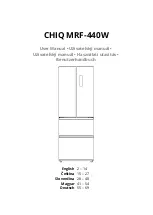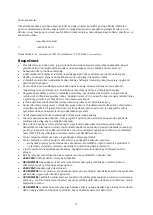
11
Categorized storage of foods
:
Foods should be stored by category, with the foods you eat every day placed
in front of the shelf, so that the door open duration can be shortened and food spoilage due to expiration
can be avoid.
Energy-saving tips: Allow the hot food cool down to the room temperature before putting it in the
refrigerator. Put the frozen food in the fresh food compartment to thaw, using the low temperature of the
frozen food to cool the fresh food, thus saving energy.
Storage of fruits and vegetables
In the case of refrigerating appliances with chill compartment, a statement to the effect that some types of
fresh vegetables and fruits are sensitive to cold and therefore are not suitable for storage in this kind of
compartment should be made.
Use of the frozen food storage compartment
The freezer temperature is controlled below -18
℃
, and it is advisable to store the food for long-term
preservation in the freezer compartment, but the storage duration indicated on the food packaging should
be adhered to.
The freezer drawers are used to store food that needs to be frozen. Fish and meat of large block size should
be cut into small pieces and packed into fresh-keeping bags before they are evenly distributed inside the
freezer drawers.
•
Allow the hot foods to cool down to the room temperature before putting them in the freezer
compartment.
•
Do not put a glass container with liquid or the canned liquid that is sealed in the freezer compartment,
so as to avoid burst due to volume expansion after the liquid gets frozen up.
•
Divide the food into appropriately small portions
•
You’d better pack the food up before freezing it, and the packing bag used should be dry, in case the
packing bags are frozen together. Foods should be packed or covered by such suitable materials as are
firm, tasteless, impervious to air and water, non-toxic and pollution-free, to avoid cross-contamination
and transfer of odour.
Tips for shopping the frozen foods
•
When you are buying frozen food, look at the Storage Guidelines on the packaging. You will be able to
store each item of frozen food for the period shown against the star rating. This is usually the period
stated as “Best to use them before×”, found on the front of the packaging.
•
Check the temperature of the frozen food cabinet in the shop where you buy the frozen foods.
•
Make sure the frozen food package is in perfect condition.
•
Always buy frozen products last on your shopping trip or visit to the supermarket.
•
Try to keep frozen food together whilst shopping and on the journey home, as this will help to keep the
food cooler.
•
Don’t buy frozen food unless you can freeze it straight away. Special insulated bags can be bought from
most supermarkets and hardware shops. These keep the frozen foods cold longer.
•
For some foods, thawing before cooking is unnecessary. Vegetables and pasta can be added directly to
boiling water or steam cooked. Frozen sauces and soups can be put into a saucepan and heated gently
until thawed.
•
Use quality food and handle it as little as possible. When foods are frozen in small quantities, it will take
less than for them to freeze up and thaw.
•
Estimate the amount of foods to be frozen up. When freezing large amounts of fresh food, adjust the
temperature control knob to the low mode, with the freezer temperature lowered. So, foods can be
frozen up in fast manner, with the food freshness well kept.
Tips for Special Needs
Moving the refrigerator/freezer
•
Location
Do not place your refrigerator/freezer near a heat source, e.g. cooker, boiler or radiator. Avoid it from direct
sunlight in out-buildings or sun lounges.
•
Levelling
Make sure to level your refrigerator/freezer using the front levelling feet. If not level, the refrigerator/freezer
door gasket sealing performance will be affected, or even it may lead to the operating failure of your
refrigerator/freezer. After locating the refrigerator/freezer in position, wait for 4 hours before using it, so as
to allow the refrigerant to settle.












































